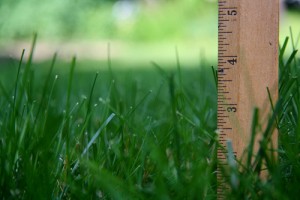 How tall should your grass be? While it may be tempting to set your deck to the lowest height to cut more at a time, that’s not the best strategy if you want a healthy lawn. Here’s what you need to know about cutting heights to keep your lawn looking lush while reducing weeding and other maintenance.
How tall should your grass be? While it may be tempting to set your deck to the lowest height to cut more at a time, that’s not the best strategy if you want a healthy lawn. Here’s what you need to know about cutting heights to keep your lawn looking lush while reducing weeding and other maintenance.
The Importance of Grass Height
It seems logical that you would want to cut the grass as low as possible and let it grow as much as possible to save labor. However, doing so can harm the grass, leading to more work patching bald spots and removing weeds. Keeping grass at the right height can save work in the long run.
If the grass is too long, it provides a habitat for undesirable animals including mice, snakes, voles and mosquitoes. Once you do mow, the added length of the grass will stress your mower, often to the point that mulching will be impossible. This means clippings will need to be bagged, removing nutrients from the soil.
If the grass is too short, it can’t put down a solid root system to keep out weeds. It also reduces ground cover, increasing the amount of sunlight reaching the soil. In turn, the water will evaporate from the soil faster during droughts and severe heat, drying out the grass.
Grass Heights by Type
These are general guidelines, with varieties of grasses responding better to specific heights within these ranges. When in doubt, ask a seed supplier about their recommendations.
- 0.25-0.75 inches : Bentgrass
- 0.5-1.5 inches: Bermuda, zoysia
- 1.5-2.5 inches: centipede, fine fescue, Kentucky bluegrass, ryegrass
- 2-3 inches: bahia, buffalograss, tall fescue
- 2-4 inches: St. Augustine
Mowing Through the Season
When first mowing in the spring, cutting near the lower limit will help remove dead blades of grass.
During droughts, cut the grass to the maximum height to help resist heat and hold in moisture.
Increased grass height can help protect the grass from snow and frost. For the best results, aim for a height of three inches for your final mow, regardless of the type of cold season grass on your lawn.
Mowing Frequency
It takes the grass some time to recover after having parts of the blades sliced off, so care should be taken to make this process as gentle as possible. As a general rule of thumb, no more than 1/3 of the grass height should be removed in a single mow. Once the grass is at the right height, wait until the grass has grown a third before cutting it again. During peak growth, this means mowing will need to be done about once a week. If you’ve let the grass get too high, mow no more than every 4-5 days to bring the grass back to the desired height. This gives the grass some time to recover.
Dealing with Thatch
If you’ve been cutting your lawn too short before, you probably haven’t had to deal with thatch. Grass clippings, stems, and other lawn debris can build up, creating a layer over the soil that can block water and oxygen from reaching the roots. With thicker grass, this underlying layer will need to be removed once per season. Cub Cadet makes dethatching attachments for their garden tractors and mowers so you can do this yourself.
Where to Get Parts for Your Cub Cadet
www.cubparts.com is a certified Cub Cadet dealer carrying all the parts you need to maintain your equipment and accessories from early tractors to the newest riding mowers. Our search engine has factory diagrams and parts descriptions built into it so you can quickly find the right parts for your mower, and we can ship your order anywhere in the U.S. and Canada.
